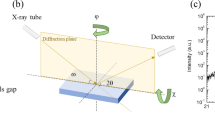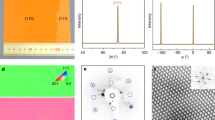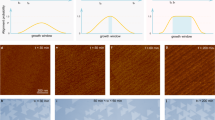Abstract
Boron sub-arsenide, B12As2, is based on twelve-atom clusters of boron atoms and two-atom As–As chains. By contrast, SiC is a tetrahedrally bonded covalent semiconductor. Despite these fundamental differences, the basal plane hexagonal lattice constant of boron sub-arsenide is twice that of SiC. This coincidence suggests the possibility of heteroepitaxial growth of boron sub-arsenide films on properly aligned SiC. However, there are a variety of incommensurate alignments by which heteroepitaxial growth of B12As2 on (0001) 6H–SiC can occur. In this study, we first used geometrical crystallographic considerations to describe the possible arrangements of B12As2 on (0001) 6H–SiC. We identified four translational and two rotational variants. We then analyzed electron backscattered diffraction and transmission electron microscopy images for evidence of distinct domains of such structural variants. Micron-scale regions with each of the two possible rotational alignments of B12As2 icosahedra with the SiC surface were seen. On a finer length scale (100–300 nm) within these regions, boron-rich boundaries were found, consistent with those between pairs of the four equivalent translational variants associated with a two-to-one lattice match. Boron-carbide reaction layers were also observed at interfaces between SiC and B12As2.
Similar content being viewed by others
References
D. Emin: Icosahedral boron-rich solids. Phys. Today 40, 55 (1987).
W.N. Lipscomb: Boron Hydrides (W.A. Benjamin, New York, 1963).
Boron and Refractory Borides, edited by V.I. Matkovich (Springer-Verlag, New York, 1977).
D. Emin, T. Aselage, C.L. Beckel, I.A. Howard and C. Wood: Boron-Rich Solids, edited by D. Emin, T. Aselage, C.L. Beckel, I.A. Howard, and C. Wood, AIP Conf. Proc., Vol. 140 (American Institute of Physics, New York, 1986).
M. Carrard, D. Emin and L. Zuppiroli: Defect clustering and self-healing of electron-irradiated boron-rich solids. Phys. Rev. B 51, 11270 (1995).
G.A. Slack, T.F. McNelly and E.A. Taft: Melt growth and properties of B6P crystals. J. Phys. Chem. Solids 44, 1009 (1983).
D. Emin: Bonding and doping of simple icosahedral-boride semiconductors. J. Solid State Chem. 177, 1619 (2004).
T.L. Aselage and D. Emin Beta Cell Device Using Icosahedral Boride Compounds, U.S. Patent 6 No. 479 919 (Nov. 12, 2002).
J.A. Perri, S. La Placa and B. Post: New group III—group V compounds—BP and BAs. Acta Crystall. 11, 310 (1958).
F.V. Williams and R.A. Ruehrwein: The preparation and properties of boron phosphides and arsenides. J. Am. Chem. Soc. 82, 1330 (1960).
R.A. Greene Jr. and P.E. Burmeister: Synthesis and growth of B6P. Trans. Met. Soc. AIME 239, 408 (1967).
T.L. Chu, J.M. Jackson, A.E. Hyslop and S.C. Chu: Crystals and epitaxial layers of boron phosphide. J. Appl. Phys. 42, 420 (1971).
M. Takigawa, M. Hirayama and K. Shohno: Hetero-epitaxial growth of lower boron phosphide on silicon substrates using PH3–B2H6–H2 system. Jpn. J. Appl. Phys. 12, 1504 (1973).
M. Hirayama and K. Shohno: Hetero-epitaxial growth of lower boron arsenide on Si substrate using AsH3–B2H6–H2 system. Jpn. J. Appl. Phys. 12, 1960 (1973).
T. Takenaka and K. Shohno: Double-layer epitaxial growth of Si and B13P2 on Si substrates and some electrical properties of Si layers. Jpn. J. Appl. Phys. 13, 1211 (1974).
V.E. Amberger and P.A. Rauh: Structure of boron-rich phosphides, Acta Crystall. B30, 2549 (1974).
T.L. Chu and A.E. Hyslop: Preparation and properties of boron arsenide films. J. Electrochem. Soc. 121, 412 (1974).
K. Shohno, M. Takigawa and T. Nakada: Epitaxial growth of BP compounds on Si substrates using the B2H6–PH3–H2 system. J. Cryst. Growth 24/25, 193 (1974).
L.A. Correia, R.C. van Oort and P.J. van der Put: Chemical vapor deposition of boron subarsenide using halide reactants. React. Solids 2, 203 (1986).
T.L. Aselage: Preparation of boron-rich refractory semiconductors, in Novel Refractory Semiconductors, edited by D. Emin, T.L. Aselage, and C. Wood (Mater. Res. Soc Symp. Proc. 97, Pittsburgh, PA, 1987), p. 101.
Y. Kumashiro, H. Yoshizawa and T. Yokoyama: Epitaxial growth of rhombohedral boron phosphide single crystal films by chemical vapor deposition. J. Solid State Chem. 133, 104 (1997).
R.H. Wang, D. Zubia, T. O’Neil, D. Emin, T. Aselage, W. Zhang and S.D. Hersee: Chemical vapor deposition of B12As2 thin films on 6H–SiC. J. Electron. Mater. 29, 1304 (2000).
R. Nagarajan, J.H. Edgar, J. Pomeroy, M. Kuball and T. Aselage: Investigation of thin film growth of B12As2 by chemical vapor deposition, in New Applications for Wide-Bandgap Semiconductors, edited by J.J. Chyi, S.J. Pearton, J. Han, A.G. Baca, J.I. Chyi, and W.H. Chang (Mater. Res. Soc. Symp. Proc. 764, Warrendale, PA 2003), p. 283.
W.A. Vetter, R. Nagarajan, J.H. Edgar and M. Dudley: Double-positioning twinning in icosahedral B12As2 thin films grown by chemical vapor deposition. Mater. Lett. 581331 (2004).
R. Nagarajan, Z. Xu, J.H. Edgar, F. Baig, J. Chaudhuri, Z. Rek, E.A. Payzant, H.M. Meyer, J. Pomeroy and M. Kuball: Crystal growth of B12As2 on SiC substrate by CVD method. J. Crystal Growth 273, 431 (2005).
D.J. Prior, P.W. Trimby, U.D. Weber and D.J. Dingley: Orientation contrast imaging of microstructures in rocks using forescatter detectors in the scanning electron microscope. Mineral. Mag. 60, 859 (1996).
M.H. Jacobs and M.J. Stowell: Moire patterns and coherent double-positioning boundaries in 111 epitaxial gold films. Philos. Mag. 11, 591 (1966).
M.P. Siegal, Saudia National Laboratories, 2003, private communication.
B. Morosin, A.W. Mullendore, D. Emin and C. Wood: Rhombohedral crystal structure of compounds containing boron-rich icosahedra, in Boron-Rich Solids, edited by D. Emin, T. Aselage, C.L. Beckel, I.A. Howard, and C. Wood, AIP Conf. Proc., Vol. 140 (American Institute of Physics, New York, 1986), p. 70.
Author information
Authors and Affiliations
Corresponding author
Rights and permissions
About this article
Cite this article
Michael, J.R., Aselage, T.L., Emin, D. et al. Structural variants in attempted heteroepitaxial growth of B12As2 on 6H–SiC (0001). Journal of Materials Research 20, 3004–3010 (2005). https://doi.org/10.1557/JMR.2005.0367
Received:
Accepted:
Published:
Issue Date:
DOI: https://doi.org/10.1557/JMR.2005.0367




